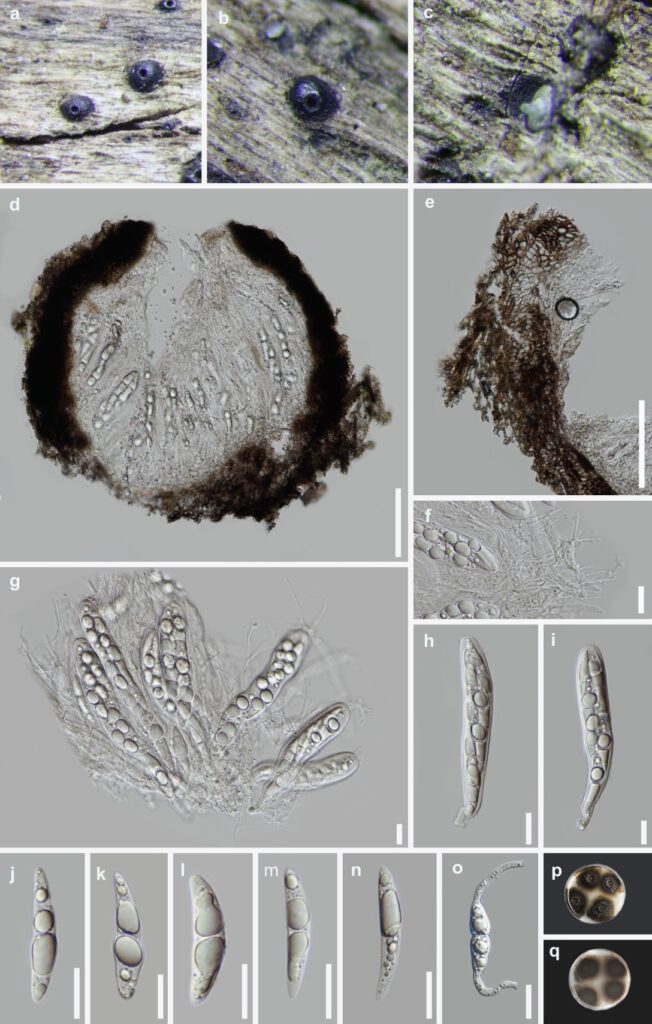Lindgomyces guizhouensis J.M, Y.Z. Lu & K.D. Hyde, sp. nov. FIGURE 1
MycoBank number: MB; Index Fungorum number: IF; Facesoffungi number: FoF 10676;
Etymology: Referring to collecting site in Guizhou province, China.
Holotypus: GZAAS 21-0383
Saprobic on decaying wood in terrestrial habitats. Asexual morph: Ascomata 396-548 μm high× 466-514 μm diam., superficial, black, smooth, scattered, solitary, erumpent, subglobose to broadly conical, with a centrally located ostiole; Peridium 44-79 μm thick, thick-walled, composed of pale brown cells of textura angularis. Hamathecium 1-2 μm wide, septate, branched, pseudoparaphyses above the Asci. Asci 110-154×15-28 μm, bitunicate, apically rounded with an indistinct ocular chamber, subsessile, fissitunicate, broadly cylindrical to clavate, obliquely uniseriate to 2-3-seriate ascospores; Ascospores 30-51×8-12 μm, (x¯ = 44.7×10.5μm, n = 25), fusiform, slightly curved with narrowly rounded ends, 1-septate, 2-4 guttules in each cells, wall gray while in the ascus, smooth or slightly verruculose. Sexual morph: Not observed.
Culture Characters: Colonies on PDA reaching 43 mm in 20 days at 25 °C, flat, filiform, gray to near-black from center to edge, with moderate aerial mycelium, smooth, irregular; In reverse, gray to pale brown.
Material examined: China, Guizhou Province, Longli, on decaying wood submerged in a freshwater stream, 2 September 2020, Jian Ma, LLSB06(GZAAS 21-0383, holotype); ex-type living culture, GZCC 21-0669. GenBank ITS:xxxx; LSU:xxxx.
Notes: In a BLASTn search of NCBI GenBank, the closest match of LSU and ITS sequence data for Lindgomyces guizhouensis is 99.54% and 96.96% similarity to L. pseudomadisonensis (KT 2742). The multi-loci phylogenetic analyses of the combined LSU and ITS sequence dataset confirmed new obtained belonging to the genus Lindgomyces, where it is sister to L. griseosporus with high support (99% BS and 1.00 PP, Figure 2). Morphologically, L. guizhouensis is also most similar to L. griseosporus in having superficial, black with roughened surface ascomata; thick peridium; bitunicate, clavate, subsessile asci and fusiform, 1-septate, guttules ascospores. However, our new collection differs from L. griseosporus in having bigger ascomata (396-548 ×466-514 μm vs 240-290 ×320-350 μm), fragile peridium and smaller asci (110-154 ×15-28 μm vs 140-180 × 24-30). Therefore, we introduce Lindgomyces guizhouensis as a new species.

Fig. 1 Lindgomyces guizhouensis (GZAAS 21-0383, holotype). a–c Superficial ascomata on unknow plant substrate. d Vertical section of an ascoma. e Peridium. f Hamathecium g Asci with hamathecium h–i Asci j–n Ascospores o Germinating ascospore p–q Colony on PDA from above and below. Scale bars: d, e = 100 μm, f-o = 20 μm
